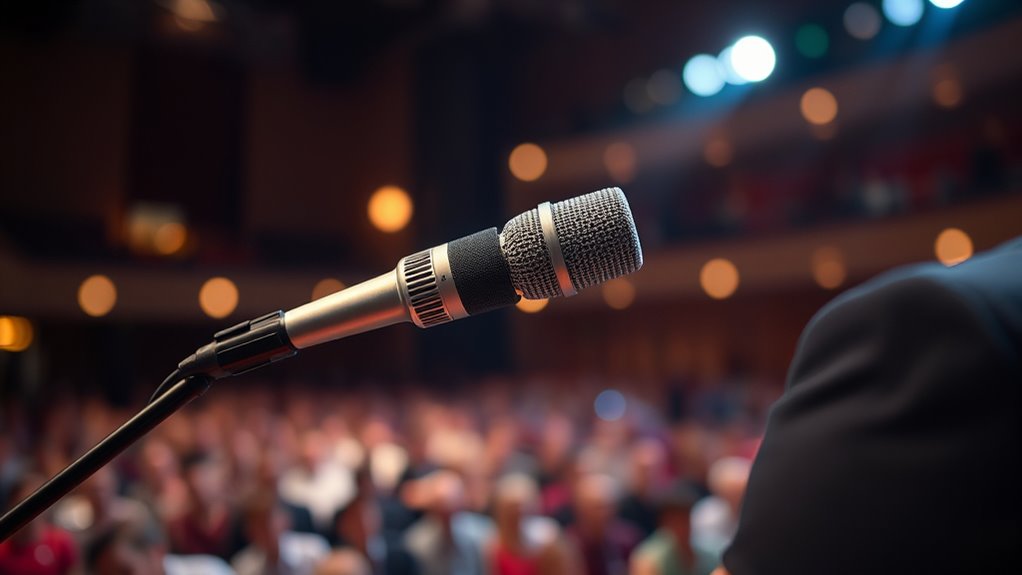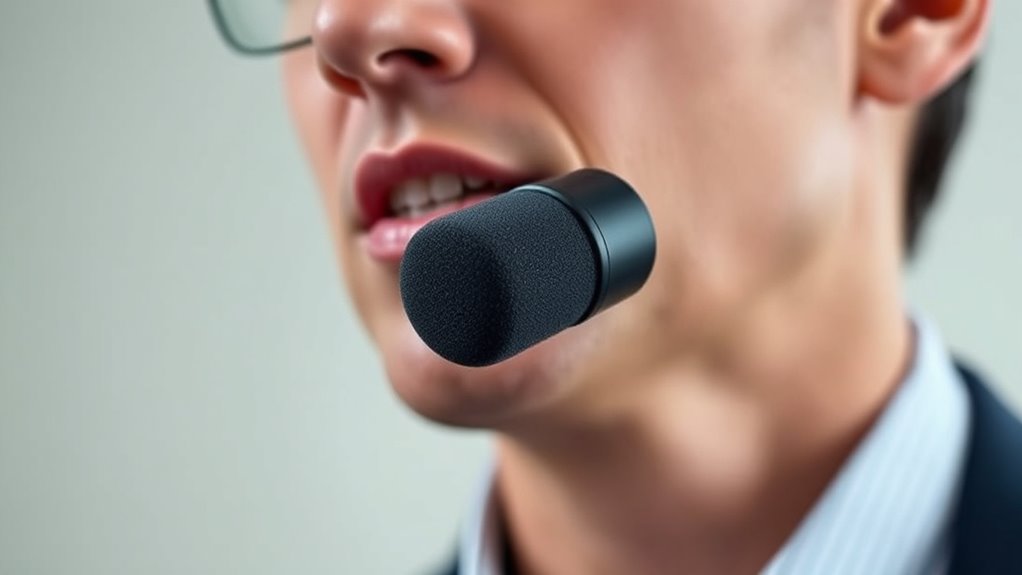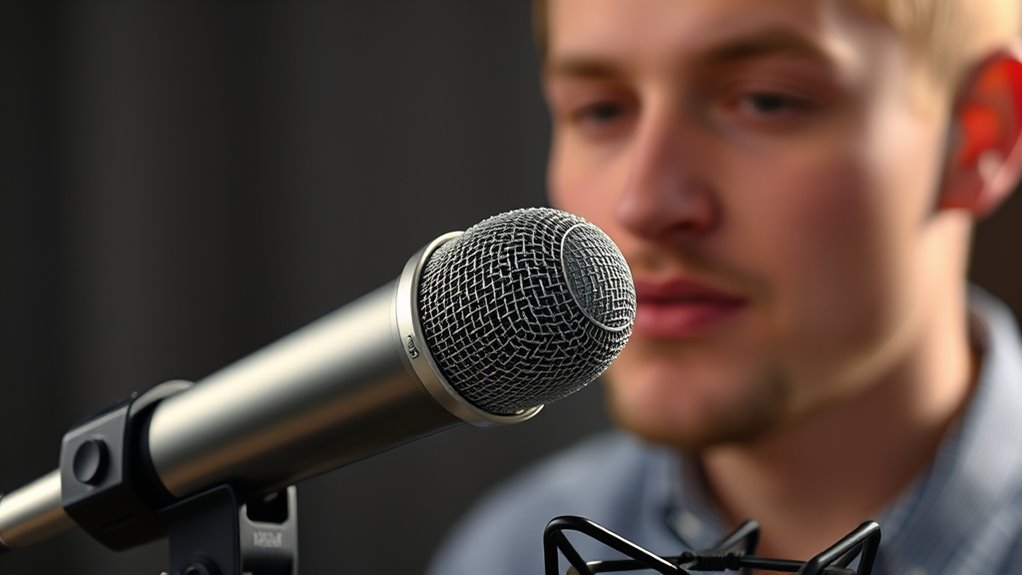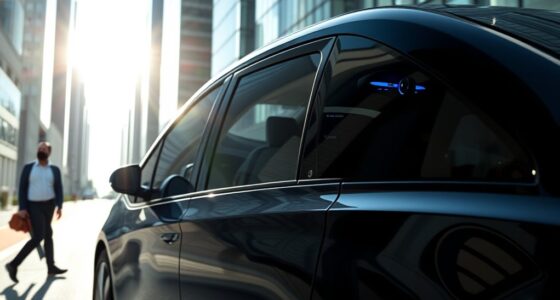Directional microphones boost speech clarity by focusing on sounds from your voice while reducing background noise. Their design shapes sound waves to pick up most directly from in front, minimizing unwanted noise from the sides and back. This helps your voice stand out clearly, even in noisy environments. You’ll find they’re ideal for conversations, recordings, and presentations. If you want to discover how technology makes this possible, continue exploring the science behind these microphones.
Key Takeaways
- They focus on sound from a specific direction, minimizing background noise and enhancing the speaker’s voice clarity.
- Their advanced directional technology suppresses ambient sounds, making speech more intelligible in noisy environments.
- Proper placement and aiming of directional microphones optimize their ability to capture clear speech.
- The microphone’s pickup pattern filters out sounds from sides and behind, reducing distractions and improving speech recognition.
- Features like noise suppression and interference shaping further enhance speech clarity by isolating the speaker’s voice from ambient noise.
Understanding the Basics of Microphone Types

Have you ever wondered how different microphones capture sound? It all starts with microphone construction. Dynamic microphones use a coil and magnet, making them durable and ideal for live recordings. Condenser microphones, on the other hand, have a capacitor element that requires power, offering greater sensitivity and detail. Ribbon microphones feature a thin metal ribbon and excel at capturing smooth, natural sound. Your recording techniques also influence mic choice—close-miking reduces ambient noise, while distant miking captures more room ambience. Each type’s design impacts how sound waves are converted into electrical signals, affecting clarity and tone. Understanding these basics helps you select the right microphone for your needs and optimize recording techniques, ensuring your audio is clear and professional. Electret microphones are a variation of condenser mics that are commonly used in consumer electronics for their portability and affordability.
The Science Behind Directional Microphones

Directional microphones are designed to focus on sound coming from specific directions while minimizing noise from others. This relies on sound wave physics, where waves arriving from different angles interfere with each other. Microphone manufacturing techniques shape and position internal components to enhance this effect, creating a directional pattern. For example, some microphones use an interference tube or multiple ports to reinforce sounds from the front while canceling out noise from the sides and back. These design choices allow the microphone to pick up speech clearly amid background noise. Understanding the science behind these devices helps explain their effectiveness. By manipulating sound wave behavior and precise manufacturing, directional microphones deliver focused audio capture, making conversations clearer even in noisy environments. Manufacturing techniques are crucial in optimizing the microphone’s directional sensitivity and overall performance.
Key Features That Improve Speech Capture

You’ll notice that focused sound pickup helps you hear speech clearly, even in noisy environments. Noise suppression capabilities further reduce background sounds, making conversations easier to follow. These features work together to enhance speech capture and improve overall clarity. Additionally, advanced microphone designs can help minimize interference from background noise, ensuring clearer communication.
Focused Sound Pickup
Focused sound pickup is a key feature that substantially enhances speech clarity by directing the microphone’s sensitivity toward you while minimizing background noise. This focused approach guarantees your voice stands out clearly, even in noisy environments. With advanced directional technology, your microphone can better capture your speech without interference. Additionally, wireless connectivity allows you to move freely without losing focus or quality. Good battery life ensures your device stays operational during long conversations or recordings, keeping you connected without interruptions. To maximize benefits, look for microphones with precise focus adjustments and reliable power management. This combination improves overall speech capture, making communication more effective and natural. Kia Tuning can also improve performance in different environments, ensuring your communication remains clear and effective.
Noise Suppression Capabilities
Noise suppression capabilities are essential for ensuring your speech remains clear even in challenging environments. They help minimize ambient noise, allowing your voice to stand out clearly. Directional microphones with advanced noise suppression focus on capturing your speech while reducing background sounds like chatter, traffic, or machinery. This greatly improves speech intelligibility, especially in noisy settings. When ambient noise is suppressed effectively, listeners can understand you without straining, even when you’re outdoors or in busy places. These features work seamlessly, enhancing overall communication quality. By filtering out unwanted sounds, noise suppression helps you deliver your message confidently and clearly, regardless of external distractions. Properly designed microphone features can significantly improve your experience in various settings. This makes directional microphones invaluable for professionals, performers, or anyone needing reliable speech clarity in noisy environments.
Common Applications of Directional Microphones

Directional microphones are widely used across various fields to improve audio clarity in challenging environments. They excel in settings where background noise needs to be minimized, making conversations clearer. You’ll find them in:
Directional microphones enhance audio clarity by minimizing background noise across diverse settings.
- Live concert recordings, where wireless connectivity lets performers move freely without sacrificing sound quality
- Conference rooms, thanks to their ergonomic design that ensures comfortable, long-term use
- Broadcast studios, to capture voices sharply amid busy backgrounds
- Personal assistive listening devices, enhancing speech understanding for individuals in noisy spaces
- In addition, the directionality of these microphones plays a crucial role in their ability to isolate sound sources effectively.
These applications leverage the strengths of directional microphones, allowing you to communicate more effectively. Their ability to focus on sound sources while maintaining mobility and comfort makes them invaluable across industries and personal use.
Comparing Omnidirectional and Directional Models

You’ll notice that omnidirectional microphones pick up sound equally from all directions, while directional models focus on specific sources. Directional microphones excel at rejecting background noise, making them ideal for noisy environments. Understanding these differences helps you choose the right microphone for your setting. Additionally, visualization techniques can assist in demonstrating how each microphone type captures sound differently.
Pickup Pattern Differences
Understanding the differences in pickup patterns is essential when choosing between omnidirectional and directional microphones. Omnidirectional mics have a circular polar pattern, capturing sound evenly from all directions, making them ideal for ambient recordings. Directional microphones, on the other hand, focus on sound coming from specific angles, thanks to their tailored polar patterns that enhance sound directionality. This focused pickup reduces unwanted noise and emphasizes the speaker’s voice. Additionally, the textile line offers various tools and techniques that can be used to optimize microphone placement and improve audio quality in different environments.
Noise Rejection Capabilities
When it comes to rejecting unwanted noise, directional microphones typically outperform omnidirectional ones because their focused pickup patterns filter out sounds from the sides and rear. This focused pattern helps improve voice recognition accuracy, making it easier to understand speech even in noisy environments. Directional microphones excel at reducing background noise, which minimizes distractions and enhances clarity. They also help prevent acoustic feedback by limiting the microphone’s sensitivity to sounds coming from unintended directions. In contrast, omnidirectional microphones pick up sound equally from all directions, making them more susceptible to unwanted noise and feedback issues. Overall, if you need better noise rejection for clearer communication and improved voice recognition, directional microphones are the better choice. Lifestyle considerations such as workspace setup can further optimize microphone performance.
Suitability for Environments
Choosing between omnidirectional and directional microphones depends largely on the environment in which you’ll use them. If you’re in a noisy setting with high background noise, a directional microphone is better suited because it focuses on sound sources in front of you and reduces environmental impact. Omnidirectional microphones, however, capture sound equally from all directions, making them ideal for environments with less background noise or when capturing ambient sounds. Consider your surroundings carefully:
- High background noise environments benefit from directional models
- Quiet settings suit omnidirectional microphones for natural sound capture
- Environments with multiple sound sources may require flexible options
- Outdoor settings demand models that handle environmental impact effectively
- Understanding sound source directionality helps in selecting the optimal microphone type for your needs
Matching your environment with the right microphone type enhances clarity and minimizes unwanted noise.
Tips for Optimizing Microphone Placement

To get the best speech clarity from directional microphones, proper placement is essential. Position the microphone close to your mouth, about 6 to 12 inches away, to maximize clarity and reduce ambient noise. Guarantee it is aimed directly at your mouth to optimize the microphone’s directional pickup pattern. Be mindful of wind resistance; use a windscreen or pop filter to minimize wind noise and protect the microphone’s frequency response. Avoid placing the mic near reflective surfaces that could cause unwanted echoes or sound distortions. Keep it steady to prevent handling noise. Proper placement not only enhances speech clarity but also preserves the microphone’s ability to reject background sounds, making your voice more intelligible in various environments.
Future Trends in Speech Enhancement Technology

Advances in artificial intelligence and signal processing are driving significant innovations in speech enhancement technology. You’ll see smarter algorithms that adapt in real-time, improving clarity even in noisy environments. Future devices will prioritize wireless connectivity, making setups more seamless and eliminating cumbersome cables. Battery longevity will also improve, allowing longer use without frequent recharging, which is essential for portable and wearable devices. Expect more integrated solutions that combine multiple features for enhanced user experience. Additionally, AI-driven noise cancellation will become more precise, tailoring sound quality to your environment. These trends will make speech enhancement more intuitive, reliable, and accessible, helping you communicate clearly in any setting.
- Smarter adaptive algorithms
- Enhanced wireless connectivity
- Longer-lasting batteries
- Real-time noise cancellation
Frequently Asked Questions
How Do Directional Microphones Perform in Noisy Environments?
In noisy environments, directional microphones excel by focusing on your voice and reducing background noise. Their microphone sensitivity is designed to pick up sounds from specific directions while ignoring unwanted sounds from others. This means you can speak clearly without the distraction of background noise, making conversations easier and more natural. You’ll notice improved speech clarity because these microphones effectively filter out background noise and concentrate on your voice.
Can Directional Microphones Be Used for Live Performances?
Imagine a spotlight on stage, focusing only on the performer, blocking out the shadows. You can definitely use directional microphones for live performances; they act like that spotlight, capturing your voice clearly. With wireless connectivity, you gain freedom of movement, while advanced designs help prevent acoustic feedback. This guarantees your sound stays crisp and focused, giving your audience a seamless experience without distractions or interruptions.
What Maintenance Is Required for Optimal Performance?
To keep your directional microphone performing at its best, follow regular cleaning routines to remove dust and debris from the grille and body. Don’t forget to check the batteries frequently, especially before important events, to guarantee they’re fully charged or fresh. Store your microphone in a protective case when not in use, and avoid exposing it to extreme temperatures or moisture. These simple steps help maintain ideal performance and clear audio quality.
Are There Specific Brands Known for High-Quality Directional Microphones?
Did you know that some brands are trusted by over 80% of professional audio engineers? When choosing high-quality directional microphones, consider brand reputation and price comparison. Popular brands like Sennheiser, Shure, and Audio-Technica are known for durability and superior sound clarity. While they might cost more upfront, their reliability often makes them a worthwhile investment for clear speech capture, ensuring you get the best performance for your money.
How Do Environmental Factors Affect Microphone Performance?
Environmental factors like background noise and wind interference can impact your microphone’s performance. When there’s a lot of background noise, your microphone might pick up unwanted sounds, making speech less clear. Wind interference can cause distortion or muffling, especially outdoors. To improve clarity, use a microphone with good wind protection and choose settings that focus on your voice, reducing the influence of these environmental challenges.
Conclusion
By choosing the right directional microphone and placing it wisely, you considerably boost speech clarity. These tools help you cut through noise and connect more effectively. Remember, a wise person once said, “A problem shared is a problem halved.” When you invest in quality equipment and techniques, you’re making your message heard loud and clear. Embrace these innovations, and watch your communication reach new heights with confidence and clarity.











